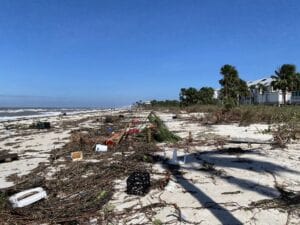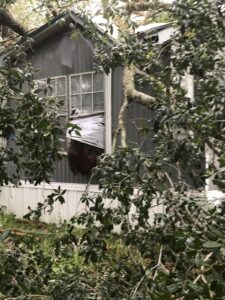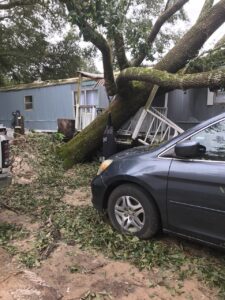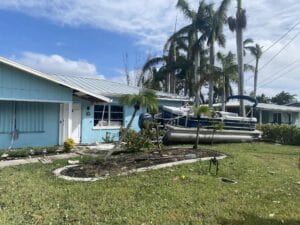Secure Your Mobile Home with Hurricane Tie-Downs
Professional hurricane tie-down installation guide and costs. Expert solutions from professionals who've protected 1,000+ mobile homes through major storms.
Installation Guide
Step-by-step hurricane tie-down installation process
Cost Breakdown
Detailed costs for all tie-down system types
Storm Protection
Maximum hurricane and tornado resistance
Smart Alternative
Cash offers - skip expensive tie-down costs
Fast cash offers • No tie-down installation needed • We buy high-risk properties
Hurricane Tie-Down Fundamentals
Understanding why hurricane tie-downs are essential for mobile home storm protection
Why Hurricane Tie-Downs Matter
Mobile homes are 15-20 times more vulnerable to hurricane damage than site-built homes. According to the National Weather Service, proper tie-downs can reduce damage risk by up to 80%.
- • Wind resistance: Secure against 110+ MPH winds
- • Foundation stability: Prevent home lifting or shifting
- • Insurance compliance: Required for coverage in high-risk areas
- • Life safety: Protect occupants during storms
How Tie-Downs Work
Hurricane tie-downs create multiple anchor points that distribute wind forces evenly across your mobile home's structure:
- • Over-the-top straps: Secure roof against uplift forces
- • Frame anchors: Connect chassis to ground anchors
- • Diagonal bracing: Resist lateral wind forces
- • Foundation integration: Work with anchor systems
Storm Statistics
Recent hurricane data shows the critical importance of proper tie-downs:
- • 85% of mobile home losses from inadequate anchoring
- • $15K+ average damage from tie-down failures
- • 6-12 hurricanes annually in Atlantic basin
- • Zone III areas: Face 110+ MPH winds regularly
Reality: Installation costs $4,000-$8,000+ but prevents $15,000+ in damage

Types of Hurricane Tie-Down Systems
Complete breakdown of tie-down options for different mobile home configurations
Best For:
- • Standard mobile homes
- • Wind Zone I & II areas
- • Budget-conscious installations
- • DIY-friendly systems
Components:
- • Heavy-duty steel straps
- • Ground anchor points
- • Frame attachment hardware
- • Tensioning systems
Best For:
- • Wind Zone II & III areas
- • Hurricane-prone regions
- • Maximum roof protection
- • Insurance requirements
Components:
- • Roof-spanning straps
- • Auger ground anchors
- • Professional installation
- • Engineered specifications
Best For:
- • Wind Zone III requirements
- • Coastal hurricane zones
- • Maximum protection
- • New home installations
Components:
- • Multiple strap systems
- • Engineered anchoring
- • Foundation integration
- • Professional certification

Professional Installation Process
Step-by-step guide to hurricane tie-down installation and requirements
🔧 Hurricane Tie-Down Installation Steps
Professional installation ensures maximum protection and building code compliance:
Site Assessment
Evaluate soil conditions, wind zone requirements, and existing anchoring
System Design
Engineer appropriate tie-down system for your specific home and location
Anchor Installation
Install ground anchors at proper depth and spacing specifications
Strap Attachment
Connect tie-down straps to home frame and ground anchor points
Tensioning
Apply proper tension to all straps according to manufacturer specs
Inspection
Professional certification and building department approval
Installation Time: 1-3 days depending on system complexity
Monitor approaching storms with live updates from the Weather Channel and National Hurricane Center
Critical for tie-down timing:
- • Install before hurricane season (May-November)
- • Allow 2-3 weeks for permits and installation
- • Schedule annual inspections before storm season
- • Emergency installers may not be available during storms
Installation Costs & Requirements
Detailed cost breakdown for hurricane tie-down systems by type and complexity
| System Type | Installation Cost | Annual Maintenance | Wind Zone Rating | Professional Required |
|---|---|---|---|---|
| Basic Strap System | $2,000 - $4,000 | $200 - $400 | Zone I & II | Recommended |
| Over-the-Top System | $4,000 - $6,000 | $400 - $600 | Zone II & III | Required |
| Complete System | $6,000 - $10,000+ | $600 - $1,000 | Zone III | Required |
| Emergency Installation | +50% premium | Same as above | All zones | Required |
Hidden Costs to Consider
- • Permits: $100-$500 depending on location
- • Engineering: $500-$1,500 for Zone III requirements
- • Soil testing: $200-$400 for anchor specifications
- • Insurance increase: May still rise despite tie-downs
- • Replacement costs: After major storm damage
- • Maintenance: Annual inspections and adjustments
Total 5-Year Cost: $8,000-$15,000+ including maintenance
Installation Requirements
- • Wind zone compliance: Must match your home's wind zone
- • Building permits: Required in most jurisdictions
- • Professional engineering: Zone III installations
- • Soil assessment: Determines anchor type and depth
- • Insurance notification: Required for coverage benefits
- • Annual inspection: Professional certification needed
Compliance failure can void insurance and create liability issues
Financing Options
- • Cash payment: Often 10-15% discount available
- • Contractor financing: 6-24 month payment plans
- • Home improvement loans: Bank financing options
- • FEMA grants: Post-disaster mitigation funding
- • Insurance discounts: May offset costs partially
- • State programs: Some states offer mitigation incentives
Alternative: Sell for cash and avoid all tie-down expenses

Inspection & Maintenance
Essential maintenance requirements to keep your hurricane tie-downs effective
Annual Inspection Checklist
- • Strap condition: Check for fraying, rust, or damage
- • Tension levels: Verify proper tightness on all straps
- • Anchor stability: Ensure ground anchors haven't shifted
- • Frame connections: Inspect all attachment points
- • Hardware integrity: Check bolts, cables, and fasteners
- • Corrosion assessment: Look for rust or deterioration
Professional inspection: Recommended annually before hurricane season
Maintenance Requirements
- • Strap replacement: Every 5-7 years or after storm damage
- • Tension adjustment: 2-3 times per year minimum
- • Anchor retightening: After soil settlement or storms
- • Lubrication: Moving parts require regular maintenance
- • Debris removal: Keep anchor areas clear
- • Documentation: Keep maintenance records for insurance
Annual maintenance cost: $400-$1,000 depending on system complexity
Post-Storm Inspection
- • Immediate safety check: Wait for official all-clear
- • Strap assessment: Look for loosening or damage
- • Anchor evaluation: Check for ground displacement
- • Frame inspection: Assess attachment point integrity
- • Professional evaluation: Required after major storms
- • Insurance documentation: Photo evidence of condition
Critical: Don't re-occupy until professional inspection confirms safety

Building Codes & Compliance
Legal requirements and standards for hurricane tie-down installations
Code Requirements
Hurricane tie-down installations must comply with multiple standards:
- • HUD standards: Federal manufactured home requirements
- • Local building codes: Municipality-specific regulations
- • Wind zone compliance: Based on geographic location
- • Engineering standards: Professional design for Zone III
- • Installation specs: Manufacturer requirements
- • Inspection protocols: Regular certification needed
Authority Reference: HUD Manufactured Home Standards
Insurance Impact
Proper tie-down installation affects insurance coverage significantly:
- • Coverage requirements: Many insurers require tie-downs
- • Premium discounts: May reduce costs by 10-15%
- • Claim eligibility: Improper installation voids coverage
- • Professional certification: Required for insurance benefits
- • Annual updates: Inspection certificates needed
- • Wind zone matching: Must meet your area's requirements
Critical: Non-compliance can void all storm damage coverage
Legal Liability
Improper or missing tie-downs create serious legal risks:
- • Personal liability: Injury to neighbors or public
- • Property damage: Flying debris from your home
- • Code violations: Fines and forced compliance
- • Insurance fraud: Claims denied for non-compliance
- • Resale issues: Buyers require code compliance
- • Emergency liability: Rescue costs if home displaced
Protection: Professional installation with certification essential
Top Hurricane Tie-Down Systems
Recommended brands and systems for maximum storm protection
Professional Grade Systems
- • Manufactured home augers: Deep penetration anchors
- • Galvanized steel straps: Corrosion-resistant materials
- • Engineered connections: Professional load calculations
- • Multiple anchor points: Distributed load systems
- • Certified installation: Licensed contractor required
- • Warranty coverage: 10+ year manufacturer warranties
Investment: $6,000-$10,000 for complete professional systems
Selection Criteria
- • Wind zone compatibility: Must match your area rating
- • Soil conditions: Anchor type based on soil testing
- • Home specifications: Weight and size considerations
- • Local regulations: Building code compliance
- • Installation expertise: Certified contractor availability
- • Maintenance requirements: Long-term service needs
Consultation: Professional assessment recommended for optimal selection
Common Installation Mistakes
- • Inadequate anchor depth: Insufficient soil penetration
- • Wrong anchor type: Mismatched for soil conditions
- • Improper spacing: Incorrect strap placement
- • Insufficient tension: Loose or over-tight straps
- • Poor connections: Weak frame attachment points
- • DIY installation: Professional expertise required
Result: System failure during storms, insurance claim denial

High-Cost Alternatives
Smart options when hurricane tie-down costs become prohibitive
Cost Reality Check
Complete hurricane tie-down systems involve significant ongoing expenses:
- • Initial installation: $6,000-$10,000+ for Zone III
- • Annual maintenance: $600-$1,000 per year
- • Storm damage repairs: $2,000-$5,000 after major storms
- • Replacement costs: Every 10-15 years
- • Insurance increases: Still face high premiums
- • Evacuation stress: Repeated storm season anxiety
15-Year Total Cost: $15,000-$25,000+ with maintenance and repairs
Cash Sale Benefits
Many homeowners choose to sell rather than face ongoing storm costs:
- • Immediate relief: No tie-down installation needed
- • Cost avoidance: Skip $10,000+ in tie-down expenses
- • Stress elimination: No more hurricane season anxiety
- • Insurance freedom: No more high-risk premiums
- • Relocation opportunity: Move to safer, lower-cost area
- • Fast process: Cash offers within 24-48 hours
We Specialize in: High-risk properties, tie-down problems, storm preparation stress
Relocation Advantages
Moving to a lower-risk area offers multiple benefits:
- • Lower insurance costs: Save $1,000+ annually
- • Minimal tie-down requirements: Zone I areas need basic systems
- • Better financing options: More lenders serve low-risk areas
- • Improved quality of life: Reduced storm-related stress
- • Property appreciation: Better long-term investment
- • Community stability: Less storm-related disruption
Popular Destinations: Interior regions with Zone I classifications
Frequently Asked Questions
Expert answers to common hurricane tie-down questions
Hurricane tie-down costs vary by system complexity and wind zone requirements. Basic strap systems cost $2,000-$4,000, while complete Zone III systems can cost $6,000-$10,000+. Professional installation, permits, and engineering add additional costs. Factor in $600-$1,000 annual maintenance.
Requirements vary by location and wind zone. Most coastal areas and high-wind zones require hurricane tie-downs for new installations and often for existing homes. Check with your local building department for specific requirements. Insurance companies typically require them for coverage in high-risk areas.
While some basic systems allow DIY installation, professional installation is strongly recommended and required for Zone III systems. Improper installation can fail during storms and void insurance coverage. Professional installers ensure code compliance, proper anchoring, and provide necessary certifications.
Quality hurricane tie-down systems typically last 10-15 years with proper maintenance. Straps may need replacement every 5-7 years due to weather exposure. Regular inspections and maintenance are essential. Systems in harsh coastal environments may require more frequent component replacement.
Hurricane tie-downs may provide 10-15% insurance discounts in some areas, but high-risk zones still face significant premiums. The savings rarely offset installation and maintenance costs. Many insurers require tie-downs but don't offer substantial discounts, especially in coastal hurricane zones.
Tie-down failure can result in mobile home displacement, total loss, injury, and liability for damage to neighboring properties. Insurance may deny claims if tie-downs weren't properly installed or maintained. This is why professional installation and regular maintenance are critical for both safety and insurance protection.
Many homeowners facing $8,000+ tie-down costs choose to sell, especially in high-risk areas with repeated storm exposure. Selling for cash eliminates installation costs, ongoing maintenance, and storm-related stress while allowing relocation to a safer area.
Install hurricane tie-downs before hurricane season (May-November) and allow 2-3 weeks for permits and installation. Avoid installing during active storm threats when contractors are unavailable. Spring installation allows time for system settling and adjustment before peak storm season.
Facing $8,000+ Tie-Down Costs?
Skip the stress and expenses of hurricane tie-down installation. We buy mobile homes in all risk zones - especially properties requiring expensive storm protection systems. Get a fair cash offer and relocate to safety.
✅ 30+ years experience • ✅ High-risk properties accepted • ✅ No storm preparation required
We specialize in hurricane-prone areas and expensive tie-down situations
Related Storm Protection Resources
Complete your storm preparedness knowledge with these expert guides
Mobile Home Wind Zone
Discover your mobile home's wind zone requirements and understand anchor specifications for proper storm protection.
Find Your Wind Zone →
